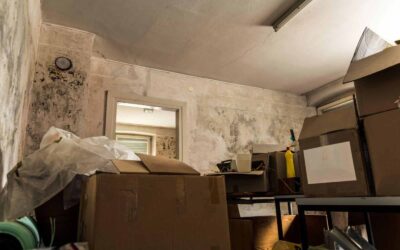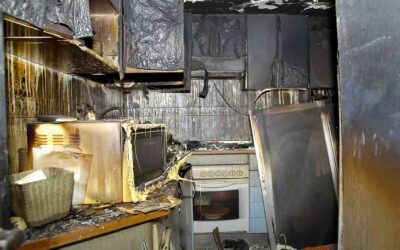While their physical size may only be measured in microns, the cumulative damage caused by mold spores adds up to billions of dollars a year in damages. That’s because mold is one of your home’s most insidious—and stubborn—invaders, quickly taking hold as soon as conditions are favorable to do so. Often hidden behind walls and above ceilings, mold colonies can silently and invisibly devastate your home’s structure, placing the health of the inhabitants at risk and sometimes rendering the area uninhabitable.
By the time you notice something is wrong, the mold may have already caused serious damage to your belongings and the structure of your home. That’s why it’s critical to recognize key signs and test for mold in your house before the infestation spreads beyond your control. The faster you catch the problem, the easier it will be for a mold remediation company like Biodynamic to eliminate the issue so you don’t need to rebuild sections of your home.
Mold: An Invisible Enemy
Mold isn’t actually invisible, of course, although a single mold spore is so small that it often cannot be seen by the naked eye. Even one spore, however, which is typically carried by air or sticking to humans or animals, can spell disaster if it lands in an environment that has favorable conditions for its growth. Such an environment includes food, warmth, and moisture.
If it finds a spot that is favorable to it, a mold spore begins to reproduce, spreading the infestation in its quest for nutrition. Mold’s preferred food source is organic cellulose, including that found in your home’s wooden support beams and other building materials. As a result, if left unchecked, mold weakens and eventually destroys these structures, causing them to fail with catastrophic results, like collapsing roofs or caved-in walls.
Is Your House a Haven for Mold Growth?
Mold is a fungus and not a plant, and therefore it does not require sunlight—but it doesn’t require darkness either. The most important thing mold needs to live and grow is water. The more moisture available, the easier it is for a mold colony to thrive and spread. That’s why mold is often found in spaces that are frequently exposed to water, such as kitchens, bathrooms, basements, crawl spaces, attics, under sinks, around exterior doors, and along window sills.
If your home has poor ventilation, this can trap humidity inside the building, adding to the moisture level and increasing the chance of mold. Similarly, if your roof is leaking due to disrepair or groundwater is seeping into the lower levels of your home, you may be at greater risk of encountering a mold infestation.
How Mold Damages Your Home
Since many of the areas listed above—under sinks, in the attic, in the basement, etc.—it’s easy to miss mold growth unless you’re looking for it or until it has done enough damage to be blatantly noticeable. Luckily, this isn’t an either/or situation: either you spot the mold the moment it starts or your home will be destroyed.
Instead, you can watch for indications of water damage (remember, mold needs moisture to grow) and the early signs that mold is starting to develop. Then you can test for mold in your house to confirm and begin the remediation process to stop the problem from getting out of hand.
So, what kind of things should you look for?
Discolored Areas
Water damage and mold both cause discoloration, so for instance, you might notice your walls or ceilings have brown or yellow spots that didn’t used to be there. This is a pretty good indicator you have water damage and that mold growth is beginning to grow in your attic or behind your walls. These stains may be accompanied by chipping paint or plaster or a stale or musty odor.
Warped Hardwood Floors
Homes with hardwood floors are particularly vulnerable to mold growth because wood is a natural food source for mold. Groundwater seepage or leaky plumbing can penetrate wooden floorboards and encourage fungal growth. As the mold grows, it may cause the wood to begin cupping and crowning as it lifts away from the subfloor.
Spots Forming on the Carpets and Furniture
It’s not just hard surfaces that you need to watch. Fabric and other fibers are susceptible as well. You may notice brown or black blotchy stains on your furniture if the mold outbreak has spread there. Similarly, discoloration on your carpets can be a tell-tale sign that an infestation has taken hold.
A Sagging Ceiling or Bowing Rooftop
If your ceiling seems like it is drooping or sagging, it could be due to the fact that water damage or a long-term mold infestation has weakened the support beams in the roof. This is a particular problem in homes where roof maintenance has been neglected, as ongoing leaks can allow mold infestations to thrive. If you notice your roof or ceiling is sagging, it could be due to mold growth and should be considered an emergency. Your roof or ceiling may be at imminent risk of collapse, and it’s time to call a professional.
Removing Mold from a Building
If you notice any of the signs we’ve mentioned above or suspect mold growth in your home for any other reason, contact experts immediately. A team will test for mold in your house, and if an infestation is present, professionals like Biodynamic will perform mold removal services to eliminate it.
Mold is a particular challenge for homeowners because simply removing it isn’t enough. The infested area must be sterilized to completely remove the mold and lower the risk of recurrence. As part of our exhaustive mold remediation process, we will not only disinfect affected areas, but we will utilize advanced technology, including bio-remediation and HEPA filters, to remove all mold spores from the building. You’ll be able to test for mold in your house again and receive a negative for the presence of mold.
Contact us today to discuss your options for mold testing and removal in your home.


